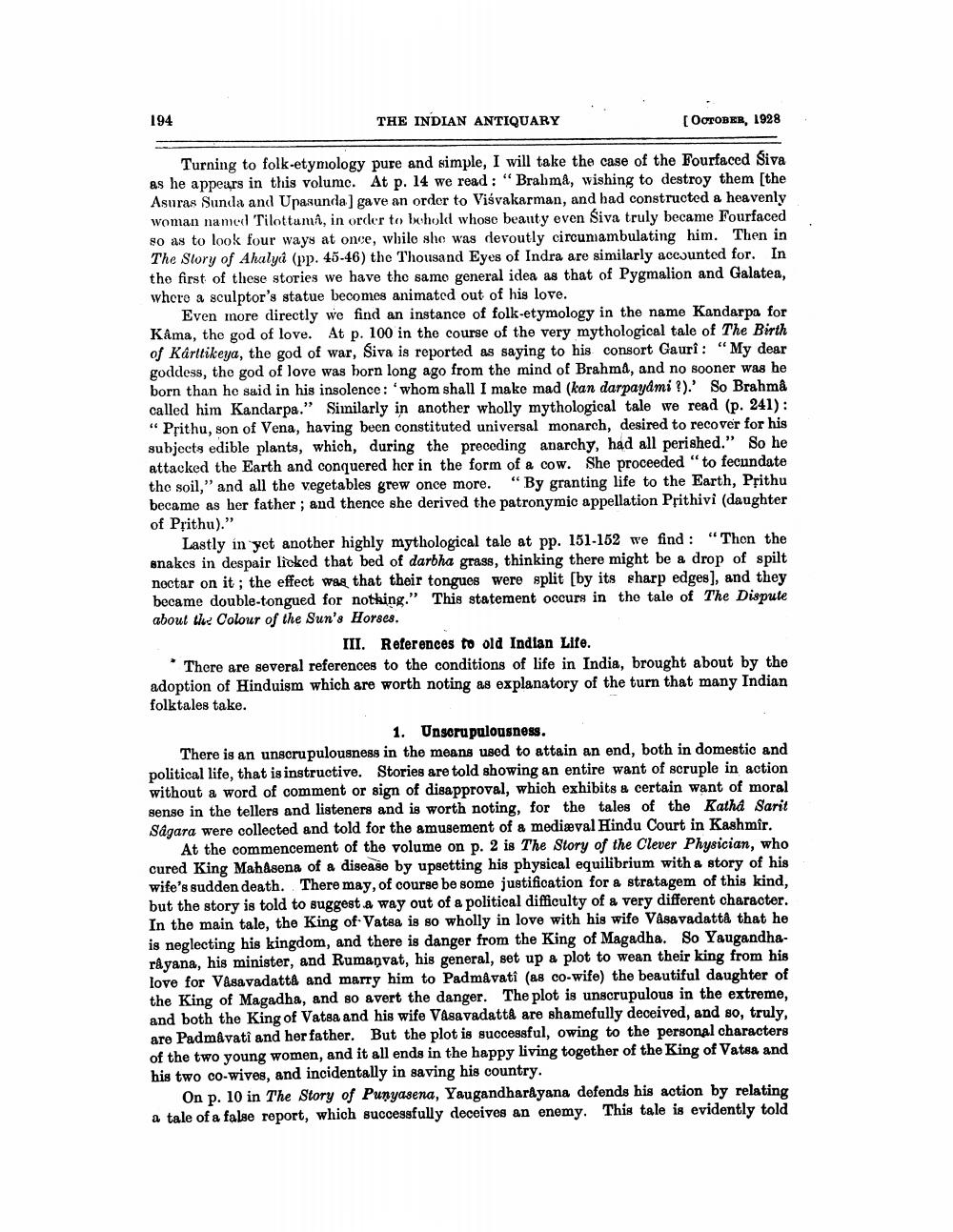________________
194
THE INDIAN ANTIQUARY
[OCTOBER, 1928
Turning to folk-etymology pure and simple, I will take the case of the Fourfaced Siva as he appears in this volume. At p. 14 we read : " Brahma, wishing to destroy them (the Asuras Sunda and Upasunda) gave an order to Viśvakarman, and had constructed a heavenly woman named Tilottuma, in order to behold whose beauty even Śiva truly became Fourfaced 80 as to look four ways at once, while she was devoutly circumambulating him. Then in The Story of Ahalya (pp. 45-46) the Thousand Eyes of Indra are similarly accounted for. In the first of these stories we have the same general idea as that of Pygmalion and Galatea, where a sculptor's statue becomes animated out of his love.
Even more directly we find an instance of folk-etymology in the name Kandarpa for KAma, the god of love. At p. 100 in the course of the very mythological tale of The Birth of Kärttikeya, the god of war, Siva is reported as saying to his consort Gaurî: "My dear goddess, the god of love was born long ago from the mind of Brahma, and no sooner was he born than he said in his insolence: 'whom shall I make mad (kan darpaydmi?).' So Brahma called him Kandarpa." Similarly in another wholly mythological tale we read (p. 241): "Prithu, son of Vena, having been constituted universal monarch, desired to recover for his subjects edible plants, which, during the preceding anarchy, had all perished.” So he attacked the Earth and conquered her in the form of a cow. She proceeded “to fecundate the soil," and all the vegetables grew once more. “By granting life to the Earth, Prithu became as her father, and thence she derived the patronymic appellation Pțithivi (daughter of Prithu)."
Lastly in yet another highly mythological tale at pp. 151-152 we find : "Then the snakes in despair licked that bed of darbha grass, thinking there might be a drop of spilt noctar on it; the effect was that their tongues were split (by its sharp edges), and they became double-tongued for nothing." This statement occurs in the tale of The Dispute about the Colour of the Sun's Horses.
III. References to old Indian Life. There are several references to the conditions of life in India, brought about by the adoption of Hinduism which are worth noting as explanatory of the turn that many Indian folktales take.
1. Unscrupulousness. There is an unscrupulousness in the means used to attain an end, both in domestic and political life, that is instructive. Stories are told showing an entire want of scruple in action without a word of comment or sign of disapproval, which exhibits a certain want of moral sense in the tellers and listeners and is worth noting, for the tales of the Katha Sarit Sagara were collected and told for the amusement of a mediæval Hindu Court in Kashmîr.
At the commencement of the volume on p. 2 is The Story of the Clever Physician, who cured King Mahasena of a disease by upsetting his physical equilibrium with a story of his wife's sudden death. There may, of course be some justification for a stratagem of this kind, but the story is told to suggest a way out of a political difficulty of a very different character. In the main tale, the King of Vatea is so wholly in love with his wife Vasavadatta that he is neglecting his kingdom, and there is danger from the King of Magadha. So Yaugandharayana, his minister, and Rumanvat, his general, set up a plot to wean their king from his love for Vasavadatta and marry him to Padmavati (as co-wife) the beautiful daughter of the King of Magadha, and so avert the danger. The plot is unscrupulous in the extreme, and both the King of Vatea and his wife Vasavadatta are shamefully deceived, and so, truly, are Padmavati and her father. But the plot is successful, owing to the personal characters of the two young women, and it all ends in the happy living together of the King of Vatea and his two co-wives, and incidentally in saving his country.
On p. 10 in The Story of Punyasena, Yaugandharayana defends his action by relating a tale of a false report, which successfully deceives an enemy. This tale is evidently told




